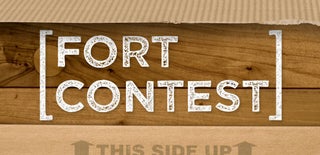Introduction: How to Improvise a Fort
Why do people love building forts? They're a "Home within a home", a secluded dwelling you built yourself. Maybe it takes us back to our caveman days, and our forts are a glorified cave. It could be that they're a place where we can hide from the world, a house which is built for no eyes but ours. Whatever the reason, building an inside fort is a great way to spend time. In this Instructable, I'll show you not only how to build one kind of fort in one kind of house, but how to improvise a fort, or build one no matter how your house is designed. You can also make it to fit your needs-big or small, tall or short, light or dark inside, for sitting, standing, lounging, or sleeping. I'll start with a few examples of forts that are "house friendly" -that is to say that they can be built in most houses. Then I'll move on to some that I built in my house with the things, dimensions of space, and size of blankets that I had.
There are three parts to a fort: The covering (usually blankets), the support (from chairs to tables to string to air from a fan), and the guts, or the stuff inside (blanket, sleeping bag, pillows, books, laptop for movies, flashlight, lamp, etc.). The third one may not seem necessary, but you try sleeping on a hard floor.
There are different kinds of forts, too: the tent fort, where there is one or more supports, and the blankets slope out and are weighed down; there's the square fort, where there's one or more supports and blankets are draped across the top and sides (the table fort falls into this category); there's the wall/ceiling fort, in which blankets are hung from walls and/or ceilings, using tacks, to make entire rooms; and there's the improv fort, made using what you have where you have, forts that few or no people have seen before.
So ask yourself, what do I need and want? What materials do I have? What space am I working in? What will I use the fort for? These questions will help govern the fort that you'll make. So have a good time making forts, and ask if you have any questions. Vote for me in the forts contest, and I'd love to see pictures of your forts in the comments. I enjoy honest feedback, too, so don't be afraid to tell the truth.
Step 1: The Chair Fort
This is a very basic fort, probably one of the first I ever made. You put two chairs back to back, 3 or 4 feet apart, then put blankets over the top, sides, and under you, on the floor. You can put blankets or quilts over the chairs to block out the light. Adaptions: If you want, you can put both chairs facing the same way, and therefore put a computer or mini TV to watch movies. It can also be a table for food, books, or homework. Other adaptions can be to add another chair, couch pillows to one side, or using tacks to attach the blanket to a wall. What adaptions can you think up?
Step 2: The Table Fort
Move the chairs away from your table and move everything on it to the center. Hang some blankets over the sides, using the stuff on your table for weights, and you have yourself a table fort. I like this particular fort, as it is roomy, dark, cool, and simple to make. This would make a great sleepover fort. Again, I would like to see what adaptions of this fort you can come up with, such as expanding the walls using the chairs.
Step 3: The Desk Fort
This was made with my computer desk. I put two chairs, back to back, a blanket's length away from the desk and hung blankets over it.
Step 4: The Support Fort, Aka the Tent Fort
This can be made two ways. One, you put one tall support in the middle (I used a keyboard stand) and drape blankets coming out from all sides like a tipi, then you weigh the edges down with books and things. Two, you either tie a string or rope between two points and drape a blanket over it, or, the way I do it, you can use two blankets, one for each side, and wedge them in between two points and weigh the edges down again, like a tent. Whatever works for you. Have fun making your forts, I would like to see pictures, and I am expecting questions, comments, and critique.

Participated in the
Fort Contest

Participated in the
Weekend Projects Contest



![A New Kind of Wilderness Survival [Updated!]](https://content.instructables.com/F6T/JJYT/HXD60BIB/F6TJJYTHXD60BIB.jpg?auto=webp&crop=1%3A1&frame=1&width=130)









